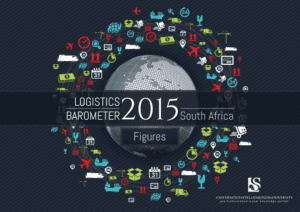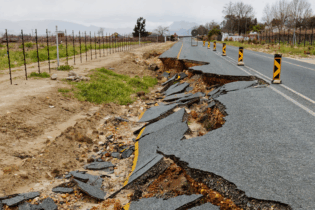Stellenbosch University’s (SU) Department of Logistics has launched the Logistics Barometer South Africa 2015.
This continues the research published with the Council for Scientific and Industrial Research (CSIR) and Imperial Logistics in the State of LogisticsTM surveys for South Africa over the past ten years. “This is an exciting development for SU as we are launching a product that is of great importance to the industry,” says Zane Simpson, a researcher in the Department of Logistics, who presented a paper on the measuring instrument at the 2015 SAPICS conference at Sun City.“With this barometer we can further contribute to the extensive knowledge base that been created with the State of LogisticsTM surveys the past ten years,” says Professor Jan Havenga, who pioneered logistics costs research at SU. The Logistics Barometer South Africa 2015 reports on logistics costs calculated up until 2013, and forecasted up to 2015. At R393 billion, logistics costs in 2013 equalled 11.1% of South Africa’s GDP. This relationship does not compare well with the figures for North America (8.8%), and Europe (9.2%), but is better than those of South America (12.3%) and Asia Pacific (12.8%). Changes in input costs are expected to increase this percentage for 2014 and 2015. South Africa is one of only three countries that routinely measures and reports logistics costs as a percentage of GDP in a quantitative manner – the others being the USA and Brazil, who measure logistics and transport costs. “This research serves the country as a whole as it is used for strategic decision making on a provincial as well as national level. It provides regulators, policy makers, infrastructure owners, economic planners and others who operate in the logistics field with intelligence to deal with the issues identified. This research puts SU on the cutting edge in terms of calculating logistics costs using international benchmarks,” says Simpson.
South Africa’s economy is transport intensive, and the Logistics Barometer identifies transport as the most significant portion of logistics costs in the country. South Africa’s GDP constitutes only 0.44% of the global GDP, yet 0.6% of the world’s road network and 2% of the world’s rail network is in this country.
South Africa accounts for more than 1% of the world’s tonne-kilometres, 1.7% of the world’s container trade and 5.1% of the world’s dry bulk trade. More than 80% of transport costs (85.1% in 2013) are due to road transport, with rail tariffs contributing between 11% – 13%, and pipeline tariffs 2% or less in recent years. The biggest contributor to road transport costs is fuel. Even with reduced tonne-kilometres in 2013, the total fuel bill was still higher than in 2012. This is attributed to a higher diesel price. The total for some of the variable costs – Including driver wages, depreciation and insurance – have seen a slight decrease. However, this is not due to a drop in input costs, but rather a slight change in industry behaviour, warn the contributing researchers and editors of the Logistics Barometer, Nadia Viljoen and David King. “The Logistics Barometer will have an international impact through the reputation of the underlying research and the long-standing collaboration between SU and other researchers globally,” says Simpson. “Our work is noticed by researchers around the world and used as an example of only a few countries where this measurement is repeated annually and used regularly. We now have 11 years of consecutive logistics costs measurements and are proud to be leaders in this field.”







